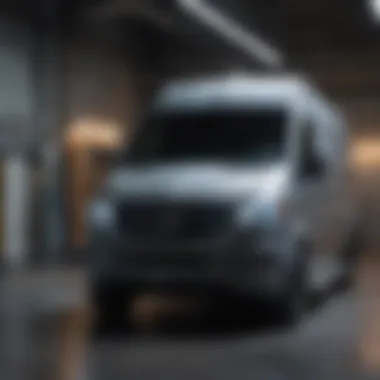The All Electric Sprinter Van: A Game Changer in Automotive


Intro
The automotive industry is undergoing a significant transformation, and one of the most captivating elements in this evolution is the rise of the all-electric sprinter van. These vehicles represent a shift not just in how we power transportation but also in how we perceive the future of urban and commercial mobility. With increasing demand for eco-friendly solutions, the electric sprinter van is not merely a trend but a necessary step toward sustainability.
Electric vans, once a concept relegated to the distant future, are now at the forefront, thanks to advancements in battery technology, charging infrastructure, and consumer awareness about environmental issues. The adoption of electric vans is being fueled by a growing awareness of the damage fossil fuels inflict on our planet and the push for greener alternatives in all aspects of life. This section will navigate through the multifaceted dimensions of electric sprinter vans and their role in reshaping transportation norms.
Through this guide, we will explore various aspects of all-electric sprinter vans, including performance capabilities, cutting-edge technologies, design features, and something many tend to overlook: their environmental impacts. With a finger on the pulse of industry trends and consumer preferences, the narrative unfolds even further with the examination of future prospects and innovations on the horizon.
To set the stage, we will delve into the vehicle reviews, analyzing how these electric marvels stack up against their internal combustion engine counterparts. Buckle in, as we take a deep dive into this electrifying topic.
Intro to All Electric Sprinter Vans
The emergence of all electric sprinter vans marks a significant shift in the transportation landscape. As more industries aim to reduce their carbon footprint, these vehicles have stepped into the spotlight for many good reasons. The topic is not just about the vehicles themselves; it's about redefining what mobility means in our modern age. These vans are a piece of the puzzle for a more sustainable future, with benefits ranging from reduced emissions to lower operating costs.
Understanding Electric Vehicles
Electric vehicles (EVs) have been gaining traction over the past decade. They represent a departure from traditional combustion engines, relying instead on electric power. Understanding EVs goes beyond just knowing they are powered by batteries. Their efficiency, recharge times, and how they fit into existing infrastructure are all part of the conversation. With the growing availability of charging stations and improvements in battery life, electric vehicles are becoming more practical for everyday use, adding to their appeal.
Defining the Sprinter Van
Sprinter vans are versatile, often used across multiple sectors such as logistics, tourism, and construction. Their design provides ample cargo space without sacrificing performance. Historically, these vans have run on diesel or gasoline engines, but the transition to electric versions is creating new possibilities. They are already known for their adaptability and spacious interiors, but the electric models promise to enhance their utility even further. This dual identity of being both a commercial vehicle and a platform for innovative technology highlights their importance in today’s market.
Transitioning to Electric
Transitioning from traditional fuel-based vehicles to electric models is not only a trend; it’s a necessity. As governments around the world implement stricter emissions regulations, businesses must adapt. Although this shift poses some challenges, the potential rewards are substantial. All-electric sprinter vans can dramatically lower running costs, particularly in relation to fuel. Moreover, they promise less frequent maintenance needs, which can be a major factor for companies balancing budgets. Adapting to electric models is about making a long-term investment. It's hard to ignore the market evidence showing a heightened demand for electric solutions in commercial operations.
By analyzing these fundamental elements, we can better understand the impact of all electric sprinter vans on the automotive sector. It's not just about what these vehicles can do; it’s about how they fit into the larger narrative of sustainability and efficiency that is so crucial today.
Design Features of All Electric Sprinter Vans
The design features of all electric sprinter vans are not just stylistic choices but fundamental components that reflect the shift towards more efficient and sustainable transport solutions. As the automotive industry morphs into an era dominated by eco-friendly technologies, these design elements respond to both functional needs and consumer expectations. Focusing on specific aspects such as exterior innovations, interior adaptations, and customization options reveals how these vans stand out in the crowd and contribute substantially to their appeal among potential buyers.
Exterior Innovations
The outer shell of an electric Sprinter Van signals its intent right off the bat. Sleek lines and aerodynamic shapes are not purely for aesthetics—they improve energy efficiency by reducing drag, which is crucial for battery-powered vehicles. Manufacturers now integrate advanced materials like lightweight composites and high-strength aluminum to lower the overall weight, which in turn increases range.
Moreover, the implementation of innovative LED lighting systems enhances visibility while being energy-efficient, reflecting the van's overall commitment to sustainability. Features like modular designs, which allow for easy upgrades and modifications over time, also provide added value for consumers looking to future-proof their investments.
"A modern Sprinter is a canvas for innovation; it's not just about getting from A to B but doing so with flair and efficiency."
Interior Adaptations for Electric Models
Inside the cabin, electric Sprinter Vans have undergone a metamorphosis that balances comfort and functionality. Firstly, the absence of a conventional engine opens up much-needed space, allowing for more versatile layouts. Many models feature customizable dashboards equipped with intuitive touchscreens, providing seamless access to vehicle data and navigation systems.
The incorporation of sustainable materials throughout the interior design, such as recycled plastics and vegan leather, further emphasizes the electric van's green ethos. Sound insulation has also seen improvements, providing a quieter ride by minimizing noise from the road and wind, essential for enhancing driver and passenger comfort.
Customization Options
One of the standout features of electric Sprinter Vans is the myriad of customization options available. Different businesses and individual drivers have unique requirements, and manufacturers recognize this diversity. Potential buyers can choose from a range of seating arrangements, storage solutions, and technology packages tailored to their specific needs.
In addition, aftermarket modification options are extensive, ranging from additional shelving for tradespeople to luxury finishes for passenger transport services. The ability to personalize these vans not only empowers users but also ensures that each vehicle can serve its purpose, whether that be for commercial logistics or a family road trip.
In summary, the design features of all electric Sprinter Vans unite form and function to create vehicles that are both visually appealing and highly practical. The integration of cutting-edge technology, sustainable materials, and customization potential resonates with modern consumers who value efficiency, comfort, and responsibility in their purchasing decisions.
Performance and Capability
The realm of electric vehicles can sometimes feel daunting, especially when we dive into the nitty-gritty of performance and capabilities. When it comes to all electric sprinter vans, this is a key area of focus. These vans are not just about moving from point A to point B; they are designed for efficient transport, seamless power delivery, and impressive handling. The core elements that distinguish electric sprinter vans are their powertrain dynamics, range, efficiency, and the all-important towing and payload capacity.
Powertrain Dynamics
The heart of any vehicle is its powertrain, and electric sprinter vans are no exception. At the core, the electric powertrain consists of a battery pack and electric motors, which work together to provide instant torque and a smooth driving experience. For example, the Mercedes-Benz eSprinter features electric motors that deliver a responsive driving feel, ensuring acceleration that can genuinely surprise. While traditional combustion engines rely on complicated gear systems to maximize performance, electric drivetrains offer a singular, uncomplicated approach, delivering power directly to the wheels on demand.
Advantages of electric powertrains include:
- Instant Torque: The torque from electric motors is available from the moment you press the pedal, providing quick and engaging acceleration.
- Fewer Moving Parts: With less mechanical complexity, electric powertrains generally require less maintenance compared to their gas burning counterparts.
- Regenerative Braking: This feature not only enhances efficiency but can extend the vehicle's range by converting kinetic energy back into battery power during braking.
Overall, the powertrain dynamics of electric sprinter vans present a compelling case for their adoption in both commercial and individual use.
Range and Efficiency
Range anxiety often looms large in discussions about electric vehicles, yet all electric sprinter vans are making strides in this regard. Depending on the model and the battery configuration, these vans can cover substantial distances on a single charge. For instance, the latest iterations promise ranges upwards of 200 miles, which is often sufficient for most urban delivery routes or weekend adventures.
Efficiency is another critical aspect, and here's what makes electric sprinter vans stand out:
- Energy Recovery: Many electric vans utilize regenerative braking not just for performance but to boost their energy efficiency, reducing the overall energy needed for operation.
- Aerodynamics and Weight: The design of these vans often prioritizes aerodynamic shapes and lightweight materials, further enhancing energy conservation.
- Route Optimization Features: Many manufacturers are integrating smart systems that analyze driving patterns to suggest the most efficient routes.
Towing and Payload Capacity
One might presume that switching to electric means compromising on functionality, but that's far from the truth with all electric sprinter vans. These vehicles do not shy away from heavy lifting; rather, they are engineered to handle impressive towing and payload capacities. For example, the Ford E-Transit can tow up to 3,800 pounds, demonstrating that power isn’t sacrificed with electric mobility.


Key considerations regarding towing and payload include:
- Torque Availability: Because electric motors provide instant torque, they can handle heavy loads with ease, ensuring smooth performance even under strain.
- Payload Ratings: These vans are built to carry a significant payload, making them ideal for logistics, trade, or transport applications.
- Chassis Design: The structural integrity of electric sprinter vans is often enhanced to accommodate the demands of payload and towing capacity.
"Electric vehicles, particularly sprinter vans, offer a blend of efficiency and functionality that pushes the limits of what we expect from commercial transport today."
Technological Advancements
In the realm of all electric sprinter vans, technological advancements serve as the backbone of their development, influencing everything from performance to user experience. The leaps made in battery technology, smart features, and safety enhancements are not merely secondary aspects; they are critical in determining the viability and attractiveness of electric sprinter vans in today's market. As the industry pushes to redefine transportation norms, these technological advancements illuminate the path forward.
Battery Technology Breakthroughs
The heart of any electric vehicle is its battery. In recent years, advancements in battery technology have transformed electric vehicles from being niche products to serious contenders in the automotive sector. With the introduction of lithium-ion batteries, manufacturers can now produce vans capable of longer ranges and faster charging times.
Some noteworthy improvements include:
- Energy Density: Newer batteries can store more power without increasing size and weight. This helps enhance the vehicle's range significantly.
- Charging Speed: Fast-charging technologies are making it possible to recharge batteries more quickly, which is a game-changer for businesses.
- Lifecycle: Extended battery lifespans mean fewer replacements over time, translating to lower total cost of ownership.
"As battery technology evolves, it's reshaping how we think about mobility."
These battery breakthroughs do not just promise a more efficient drive but also align with the growing demand for sustainability among consumers. In a world where carbon emissions are under scrutiny, leveraging cutting-edge battery technology is a step toward greener business practices and environmental stewardship.
Smart Features and Connectivity
Modern electric sprinter vans are no longer just about getting from point A to point B. They come packed with a range of smart features that significantly enhance user experience and operational efficiency. These innovations create a seamless interface between the driver, the vehicle, and external systems, changing how operations are managed.
Key advancements include:
- Fleet Management Tools: Advanced connectivity options allow for real-time data sharing. Fleet managers can track vehicle locations, drive patterns, and maintenance needs, streamlining operations.
- Infotainment Systems: Enhanced entertainment and communication systems cater to both drivers and passengers, making long trips less monotonous.
- Navigation and Route Optimization: By integrating real-time traffic data, these vehicles can choose the fastest and most efficient routes, saving time and energy.
The integration of smart technology signifies a paradigm shift in how businesses are approaching transport operations. A focus on convenience, efficiency, and connectivity has emerged as a key interest among consumers and companies alike, making these vehicles much more than just utility vans.
Safety Enhancements
Safety has always been paramount in the automotive industry, and electric sprinter vans are no exception. With technological advancements, these vehicles come loaded with numerous safety features designed to protect drivers, passengers, and pedestrians alike.
Some essential safety enhancements include:
- Driver Assistance Systems: Features like lane-keeping assistance, adaptive cruise control, and automatic emergency braking are becoming standard in many electric sprinter vans.
- Robust Construction: The integration of advanced materials improves crashworthiness, with manufacturers focusing on creating vans that can withstand impact better.
- Predictive Maintenance Alerts: By utilizing sensors and connected technology, drivers can receive alerts about potential mechanical issues before they escalate into serious problems.
As the landscape of commercial transport continues to evolve, safety innovations within electric sprinter vans are becoming commonplace, giving peace of mind to users and complementing the overall value proposition.
Environmental Impact
The significance of environmental impact in the context of all-electric sprinter vans cannot be overstated. As urban and commercial areas increasingly confront the challenges of pollution and greenhouse gas emissions, the shift towards electric vehicles emerges as a key strategy to alleviate these burdens. This section sheds light on numerous facets of environmental impact—especially how electric sprinter vans can play a pivotal role in reducing carbon footprints, enhance sustainability practices during production, and positively influence urban ecosystems.
Reduction of Carbon Footprint
One of the most striking advantages of adopting all-electric sprinter vans is their potential to dramatically lower carbon emissions. Since these vehicles operate on electric power, they do not emit tailpipe pollutants that contribute to air quality issues. This is particularly critical in congested city areas, where air pollution can reach alarming levels. According to various studies, switching from traditional diesel vans to all-electric models can reduce overall carbon dioxide emissions by up to 70% over the lifecycle of the vehicle.
Moreover, the environmental benefits extend beyond just the vehicle operation. The source of electricity also matters. If the energy comes from renewable sources like solar or wind, the carbon footprint shrinks even further. Organizations aiming to reflect a commitment to sustainability can leverage electric sprinter vans as a core part of their green strategy, sending a strong message to consumers about their environmental priorities.
Sustainability Practices in Production
The manufacturing processes used for all-electric sprinter vans often embrace a smorgasbord of sustainability practices. Many companies are making conscious decisions to minimize waste and optimize energy efficiency in their production lines. For instance, manufacturers might use recycled materials in vehicle components or employ energy-efficient technologies in factories.
The shift toward renewable resources and sustainable production methods not only helps in reducing waste but also presents opportunities for manufacturers to innovate—because eco-friendliness often goes hand in hand with cutting-edge technology.
Examples include the use of water-based paints and sustainable packaging processes to transport vehicle parts. This shift transcends merely satisfying regulations, as it reflects a broader commitment to corporate responsibility and environmental stewardship. Such practices not only reduce the ecologic footprint but can also enhance brand loyalty among consumers increasingly focused on sustainability.
Impact on Urban Ecosystems
The introduction of all-electric sprinter vans has a profound effect on urban ecosystems. By reducing noise pollution and lowering carbon emissions, these vehicles help create a more livable environment for city dwellers. Quiet, stealthy operational capabilities contribute to serene public spaces, allowing people to engage more with their surroundings.
Additionally, reduced emissions foster better air quality, which can lead to improved public health outcomes. Cities are more likely to see lower rates of respiratory diseases and other health issues stemming from air pollution when electric vehicles replace traditional ones.
Furthermore, the electrification of transportation can lead to smarter urban planning. With the demand for charging stations increasing, cities may rethink their infrastructure to accommodate these needs, integrating more green spaces and accessible public transport options—thus crafting a forward-looking urban environment.
Consumer Perspectives
Understanding consumer perspectives when it comes to all-electric sprinter vans is essential for grasping the current shifts happening within the automotive industry. As preferences evolve, it's vital to pinpoint how these shifts can influence not just purchasing decisions, but also broader market trends. Electric vehicles, particularly all-electric vans, are not simply seen as alternative modes of transport; they represent a shift towards sustainable solutions that align more closely with modern values. This is particularly relevant for businesses looking to optimize operations in an eco-friendly manner.
Shifting Buyer Preferences
The trend toward electric is gaining ground rapidly, especially among businesses that rely on sprinter vans for services. A key factor driving this change is the increasing awareness of environmental issues. Today's consumers, especially younger generations, are more inclined to choose products and services that reflect their commitment to sustainability. Numerous studies have shown that businesses are recognizing that investing in electric vans can improve their public image while fulfilling corporate social responsibilities.
Moreover, consumer demand for advanced technology also plays a role in shaping these preferences. Buyers now often desire vehicles equipped with smart features, which have become synonymous with electric models. A van with connectivity options, like remote tracking or fleet management through apps, is much sought after. This trend is mirrored in customer testimonials, highlighting satisfaction with their transitions to electric units.
Challenges of Transitioning from Gas to Electric
Despite the growing inclination towards electric sprinter vans, several challenges remain for potential buyers. One notable hurdle is the emotional and psychological aspect tied to the shift from traditional gas vehicles. Many buyers feel apprehensive about the new technology, fearing reliability issues or questioning the functionality compared to established gasoline models.


Another key concern is the availability of charging infrastructure. Many potential buyers live or operate in areas where charging stations are sparse. In rural and semi-urban locations, this lack can seriously deter consumers from fully embracing electric vehicles. The range anxiety is a real concern, as buyers might hesitate to switch if they feel they’re stepping into the unknown. Beyond practical concerns, there’s also resistance due to perceived high initial costs associated with electric vans. This perception can be a steep barrier to entry for many businesses navigating already thin profit margins.
Incentives for Electric Vehicle Adoption
Governments worldwide have recognized the significance of promoting electric vehicles, often implementing various incentives to alleviate concerns associated with transitioning from gas to electric.
- Tax credits have been a significant motivator for buyers investing in electric vehicles. Many regions offer substantial deductions that can offset the purchase price, making the switch more appealing.
- Grants and rebates are also provided by municipalities, encouraging businesses to make the leap in their fleet.
- Moreover, some areas have begun to establish low-emission zones, penalizing gas vehicles while promoting electric models, creating a compelling economic argument for switching.
- Automakers are also stepping up, often providing financing plans tailored to make electric purchases more manageable, truly sweetening the deal.
As consumers become increasingly informed and regulation continues to push for greener practices, the incentives not only help mitigate transition challenges but also pave the way for broader acceptance of all-electric sprinter vans, and ultimately fuel the growth of more sustainable transportation solutions.
The push for all-electric vehicles is more than just a trend; it’s a necessary step towards a more sustainable future.
Business Applications and Commercial Uses
The commercial landscape is shifting, and nowhere is this more evident than in the growing adoption of all electric sprinter vans. As sustainable technologies become increasingly feasible, businesses across sectors are keen to leverage the numerous advantages these vehicles offer. Understanding business applications and commercial uses for electric sprinter vans is crucial, as it lays the foundation for recognizing their relevance not only in today's market but also in the future of transportation.
From logistics to tourism, and construction, the impact and implications of these vehicles are profound. Below, we delve deeper into various sectors that stand to benefit from the integration of all electric sprinter vans.
Logistics and Delivery Services
In the logistics sector, efficiency is king; every inch of space and every dollar counts. All electric sprinter vans are reshaping the delivery landscape by streamlining operations. They offer a unique blend of spaciousness and eco-friendliness, which makes them an attractive option for businesses aiming to match consumer demand with sustainability efforts.
- Cost Efficiency: By reducing fuel expenses and maintenance costs, the switch to electric is proving to be a game-changer.
- City-Friendly Design: Electric models often come with quieter operations and lower emissions, enabling businesses to navigate urban environments with ease.
Furthermore, companies benefit from potential government incentives aimed at promoting electric vehicle usage. These could include tax refunds and rebates, which can soften the blow of initial higher acquisition costs.
Tourism and Shuttle Services
The tourism sector is another area ripe for transformation through the deployment of all electric sprinter vans. As travelers become increasingly environmentally conscious, there is a burgeoning demand for sustainable transport options. Electric vans can serve as shuttles, offering comfortable, quiet, and scenic experiences without the underlying guilt of carbon emissions.
- Eco-Friendly Tours: Guided trips can now feature electric vans, giving thought to ecological impacts while satisfying adventurous spirits. It’s a win-win for both the environment and visitor satisfaction.
- Enhanced Brand Image: For businesses operating in tourism, adopting all electric sprinter vans bolsters their green credentials, setting them apart from competitors and appealing to a more conscious clientele.
Construction and Trades
While the construction industry may not seem the most obvious candidate for electric vehicles, the shift is happening. As regulatory frameworks tighten, companies in the trade sector are turning to electric sprinter vans to haul materials efficiently while leaning into environmental standards.
- Durability and Performance: Electric vans are more robust than they appear, providing significant towing capacity and adequate payload levels, essential for any construction job.
- Less Downtime: With fewer moving parts than internal combustion engine vehicles, these vans promise less breakdown time, keeping sites humming along without interruptions.
In summary, all electric sprinter vans are not just a passing trend but an essential tool for various business applications. Their advantages range from cost reductions to improving environmental impact, and as regulations evolve, their significance is only set to escalate. Businesses must adapt or risk being left in the dust as electric becomes the norm.
Challenges Facing Electric Sprinter Vans
In the landscape of electric vehicles, all electric Sprinter vans emerge as a promising solution for commercial transportation. However, these vehicles, while innovative, are not without their obstacles. Addressing the challenges they face is crucial in understanding their role within the automotive sector and how they can effectively serve businesses and consumers alike.
Infrastructure Limitations
One of the significant challenges is the current infrastructure limitations. Unlike gasoline vehicles that can refuel at multiple gas stations almost everywhere, electric vehicles, including Sprinter vans, require a robust network of charging stations. Unfortunately, many regions still lack comprehensive charging networks. For businesses relying on these vans, the absence of nearby charging points can lead to significant downtime.
Regulatory bodies and private entities are making strides to expand the presence of charging infrastructure, but it's a slow process. Fleet operators often find themselves developing workarounds, such as planning routes based on charging locations, which can complicate logistics. Moreover, public charging options can sometimes lead to long wait times, especially during peak hours. To put things into perspective, if you've ever been stuck waiting for a charging slot while a truck is refueling, you know the feeling of frustration that can brew.
High Initial Costs
Another barrier that many potential buyers encounter boils down to high initial costs. The purchase price for an all electric Sprinter van can be significantly higher than its traditional counterparts. Although the long-term savings on fuel and maintenance costs can make it an economically viable option, the upfront investment presents a hurdle for many businesses.
Take, for instance, a small delivery service. Investing in an electric van may mean cutting back on hiring more workers or expanding to new routes. This initial financial outlay can jeopardize cash flow for smaller operations. Until the market adapts and the prices begin to fall, prospective buyers will have to think hard about their financial strategies.
Technological Hurdles
Finally, the technological hurdles cannot be ignored. While electric Sprinter vans boast impressive advancements in battery technology and efficiency, they still grapple with issues like range anxiety. Despite improvements, worries about running out of battery during a critical delivery remain prevalent among users.
Furthermore, software integration for fleet management remains a work in progress. Companies need reliable systems that allow for real-time tracking and efficient route planning. If the tech doesn't hold up, businesses could end up losing money, instead of saving it.
"Without robust technological solutions, the potential of all electric Sprinter vans is limited."
By understanding these challenges, stakeholders in the automotive sector can better navigate the complexities associated with integrating all electric Sprinter vans into their operations. Only through addressing these obstacles can the full potential of these vehicles be realized.
Future Trends for All Electric Sprinter Vans
The future of all electric sprinter vans presents a landscape ripe with transformation and innovation. As the automotive industry embraces this shift toward electrification, various trends will shape the way these vans are designed, utilized, and integrated into both personal and commercial applications. It is paramount that stakeholders—from manufacturers to consumers—grasp these trends to fully envision how they may impact the broader transportation ecosystem.
Autonomous Driving Potential
The journey toward autonomous driving is more than just a technological marvel; it stands to revolutionize how all electric sprinter vans fit into our daily lives. Envision a time where vans can navigate city streets with little to no human input, improving efficiency, safety, and potentially reducing traffic congestion.
By integrating advanced sensor systems, machine learning capabilities, and real-time data processing, electric sprinter vans are poised to evolve into self-driving units that can handle deliveries or shuttle passengers without direct oversight. This could lead to enhanced productivity in various sectors, such as logistics and tourism, where time-saving solutions are invaluable.
Moreover, autonomous technology can also reframe driver employment dynamics, presenting both challenges and opportunities that deserve scrutiny. It is also worth considering how the regulatory landscape is adjusting to accommodate these advancements.
"As we step closer to a future where vehicles operate independently, the implications stretch beyond just aesthetics; they redefine the very framework of transport services."
Smart Fleet Management Solutions


The capability to optimize fleet operations is vital for businesses relying on sprinter vans for transportation and logistics. Integrating smart fleet management solutions can usher in a new era of efficiency for electric vans. Here, technology such as AI and IoT (internet of things) steps in, offering real-time analytics on vehicle performance, route planning, and maintenance scheduling. With a focus on predictive maintenance, companies can reduce downtime and improve their overall operational efficiencies.
The synergy between electric powertrains and data-driven fleet management will also lead to significant cost benefits for companies, particularly in fuel savings. Many businesses are already gearing up to adopt these technologies, seeing the writing on the wall; those who don’t might be left in the dust.
Benefits of Smart Solutions:
- Cost Efficiency: Reduced operational costs due to better route management and less maintenance.
- Maximized Uptime: Proactive maintenance that ensures vehicles are ready to roll, minimizing disruptions.
- Data-Driven Decisions: Allow businesses to make informed choices about expansions or changes in fleet composition.
Evolving Regulations and Standards
With the rapid advancements in technology, regulations governing electric vehicles and their operations are also on the move. Governments are slowly but surely ironing out policies that matter for the safe implementation of electric vans. This will not only guide manufacturers in vehicle design but also ensure that the charging infrastructure can handle the growing fleet of electric vehicles.
As new norms and standards emerge, they’ll govern everything from emissions to safety protocols, necessitating that manufacturers remain compliant while also innovating. Stakeholders must pay attention to these evolving guidelines, as they can carry implications not only for production practices but also for market competitiveness.
In summary, understanding these trends is crucial for anyone invested in the future of all electric sprinter vans. Through autonomous driving capabilities, the integration of smart fleet management solutions, and adapting to evolving regulations, the future promises to bring forth innovations that can redefine how we perceive and utilize transportation for both commercial and personal journeys.
Comparison with Traditional Sprinter Vans
The emergence of all electric sprinter vans is not just a trend; it marks a significant pivot in the automotive sector, directly contrasting with traditional internal combustion engine models. This section will delve into the aspects that differentiate the two, namely performance metrics, cost of ownership, and maintenance considerations. Understanding these differences is crucial for both commercial and personal users contemplating a shift towards electric vehicles.
Performance Metrics
When considering performance, electric sprinter vans offer a different calibration compared to their traditional counterparts. Key performance indicators such as acceleration, torque, and overall drivability showcase this distinction.
- Instant Torque: Electric motors are known for providing full torque as soon as you hit the accelerator. This characteristic results in faster initial acceleration, making electric vans great for urban conditions where stop-and-go traffic is common.
- Consistent Power Delivery: With an all electric van, you don't often see the RPM drops associated with internal combustion engines. The delivery of power is more linear, resulting in smoother handling and consistent driving performance under various loads.
- Weight Distribution: Due to the placement of heavy batteries, electric vans often have a lower center of gravity, which can improve stability, especially during sharp turns.
While traditional sprinter vans excel in certain aspects, particularly in longer highway travel with range and refueling ease, electric models are trending towards advancements that may redefine these metrics in the coming years.
Cost of Ownership
The question of cost is particularly pertinent for businesses and consumers evaluating their budgets. Initially, electric sprinter vans may seem pricey compared to traditional models, but several factors can shift this perception.
- Fuel Savings: Electric vehicles charge at a fraction of the cost of gasoline or diesel, resulting in substantial savings over time. It's not unusual to see a vast difference in fuel expenditure, especially for companies that rely heavily on their vehicles.
- Incentives and Tax Rebates: Many local and state governments offer incentives for electric vehicle purchases. These rebates can significantly reduce the upfront cost, making electric vans more appealing financially.
- Insurance and Resale Value: Electric vehicles often have lower insurance costs due to fewer moving parts and potentially longer life spans. Additionally, as electric vehicles gain traction, their resale values may remain strong, adding value in the long run.
Maintenance Considerations
Maintenance is an essential part of vehicle ownership and one area where electric vans have a distinct advantage over traditional sprinter vans.
- Fewer Moving Parts: Electric vehicles typically have less complexity in terms of mechanical components. This implies fewer parts that may require repair or replacement over their lifespan. No oil changes, less frequent brake replacements, and no fuel systems to fuss with can simplify ownership greatly.
- Battery Care: Nonetheless, battery health is a crucial aspect of maintenance for electric vans. Keeping the battery in optimal condition requires specific practices, including monitoring charging habits and ensuring it is not fully drained often.
- Software Updates: Modern electric vans incorporate software that can be updated remotely, similar to smartphones. This can enhance performance and add new features without the need for a garage visit.
"The shift towards all electric vans is not just a trend; it's a revolution in how we think about transportation."
By assessing these comparisons, automotive enthusiasts and prospective buyers can grasp how all electric sprinter vans are shaping the future while addressing modern needs.
For further reading on electric vehicles, check out resources on Wikipedia, and delve into community discussions on Reddit.
Case Studies of Successful Implementations
The case studies of all electric sprinter vans provide a tangible look into how these vehicles are not just a theoretical advancement in the automotive industry, but rather a practical solution that is being adopted in real-world scenarios. Successful implementations shed light on their application across various sectors. This not only demonstrates the feasibility of electric vans but also illustrates the numerous benefits they bring to businesses and urban landscapes alike. The insights drawn from these studies are essential for understanding the broader impact of electric vehicles in society.
Early Adopters in Commercial Settings
Several companies have jumped on the electric sprinter van bandwagon, eager to make a statement about sustainability while improving operational effectiveness. For instance, a delivery service in New York City recently incorporated all electric sprinter vans into their logistics fleet. Their decision was driven by the pressing need to reduce emissions and cater to urban regulations that favor low-emission vehicles. After a year of operation, not only did the company see a drop in fuel costs, but they also enjoyed an increase in customer satisfaction due to their commitment to green practices. This case illustrates that electric vans can yield both ecological and economic benefits, proving that green choices don't always mean compromising profitability.
Impact on Urban Mobility Solutions
Cities are buzzing with initiatives aimed at boosting urban mobility, and electric sprinter vans are often at the center of these efforts. In a notable project, a local government partnered with a transportation service to use all electric vans for their public shuttle system. The inclusion of these clean vehicles not only reduced noise pollution but also lessened the carbon footprint associated with public transport. Commuters reported feeling more at ease riding in these electric vehicles, noting the smoother rides compared to their gasoline counterparts. The project not only enhanced public transport access but also encouraged recycles of urban space, illustrating how electric sprinter vans contribute to smarter, cleaner cities.
Feedback from End Users
Gathering insights from the end users who interact with all electric sprinter vans daily provides a fuller picture of their effectiveness. A survey conducted among drivers and fleet managers revealed a largely positive reception. Drivers appreciated the ease of operation, citing that the acceleration was immediate and the ride was generally more comfortable. Fleet managers highlighted the lower maintenance costs compared to traditional vans, as fewer moving parts resulted in less wear and tear. However, some users pointed out the learning curve associated with charging infrastructure, indicating that more robust solutions are needed for wider adoption. The gathering of this feedback is essential for continuous improvement and innovation in design and functionality of electric sprinter vans.
Successful implementations of electric sprinter vans demonstrate their versatility and efficacy in various sectors, catering not just to corporate social responsibility but also enhancing functionality in urban environments.
Culmination and Implications
The emergence of all-electric sprinter vans is not merely a technological shift; it represents a pivotal transition in how we envision transportation in both commercial and urban settings. The implications are far-reaching, as these vehicles promise to redefine efficiency, sustainability, and consumer expectations. The landscape of the automotive sector is shifting—moving away from traditional diesel and gasoline-powered vehicles towards a more environmentally considerate future. By adopting electric vehicles, stakeholders can significantly contribute to reducing greenhouse gas emissions while simultaneously meeting the growing demand for sustainable mobility solutions.
Summarizing Key Insights
Throughout this article, we have examined various facets concerning all-electric sprinter vans. The key insights can be distilled into several critical points:
- Performance and Capability: Today's electric sprinter vans deliver impressive power and range, comparable to their traditional counterparts. Advancements in battery technology contribute significantly to this leap.
- Technological Innovations: Features like smart connectivity, autonomous driving potential, and comprehensive safety enhancements have become standard. They blend utility with cutting-edge tech that appeals to both businesses and consumers.
- Environmental Impact: Transitioning to electric vans is a crucial measure in combating climate change. Lesser emissions contribute directly to cleaner air in urban areas, thereby positively impacting public health.
Looking Ahead: The Future of Transportation
As we gaze into the horizon, the trajectory for electric sprinter vans appears promising. Future developments may involve a deeper integration with digital technologies like AI for improved fleet management and predictive maintenance. Moreover, regulatory frameworks are likely to become more favorable, bolstering the transition to electric fleets:
- Autonomous features will likely become more sophisticated, enabling seamless operation and potentially reducing labor costs for operators.
- Improved charging infrastructure will facilitate longer trips and enhance overall convenience, addressing one of the major challenges faced by electric vehicle users today.
- Sustainability initiatives will continue to evolve, enhancing the recyclability of vehicle materials and encouraging manufacturers to adopt greener production methods.
Call to Action for Stakeholders
In light of the insights and trends discussed, the call to action for stakeholders cannot be overstated:
- Governments should prioritize reinforcing charging infrastructure and creating incentives for businesses to transition to electric fleets. This strategic move can leverage funding and benefits from various sectors.
- Businesses need to invest in understanding the total cost of ownership of electric vs. traditional vans. Long-term savings in operational costs, combined with environmental accountability, can enhance brand reputation significantly.
- Consumers are encouraged to engage with brands proactively, expressing preferences for environmentally friendly options, thus making a significant impact on market dynamics.
By acting strategically and collaboratively, we can pave the way for a robust future where all-electric sprinter vans not only serve as practical vehicles but also as symbols of progress within the automotive industry.







